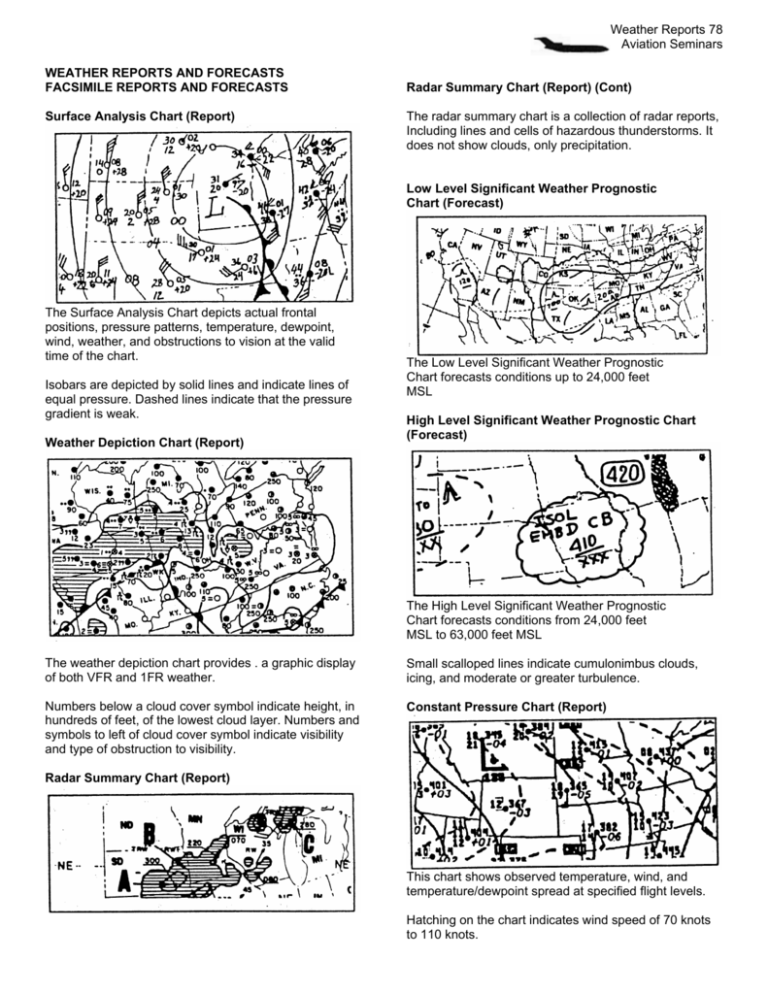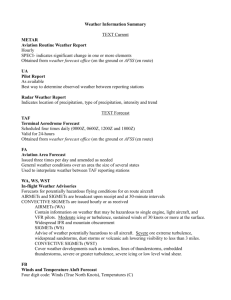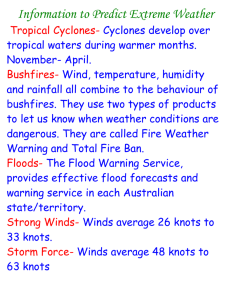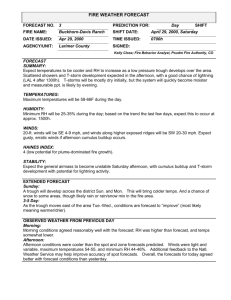Weather Reports 78 Aviation Seminars WEATHER REPORTS AND
advertisement

Weather Reports 78
Aviation Seminars
WEATHER REPORTS AND FORECASTS
FACSIMILE REPORTS AND FORECASTS
Surface Analysis Chart (Report)
Radar Summary Chart (Report) (Cont)
The radar summary chart is a collection of radar reports,
Including lines and cells of hazardous thunderstorms. It
does not show clouds, only precipitation.
Low Level Significant Weather Prognostic
Chart (Forecast)
The Surface Analysis Chart depicts actual frontal
positions, pressure patterns, temperature, dewpoint,
wind, weather, and obstructions to vision at the valid
time of the chart.
Isobars are depicted by solid lines and indicate lines of
equal pressure. Dashed lines indicate that the pressure
gradient is weak.
Weather Depiction Chart (Report)
The Low Level Significant Weather Prognostic
Chart forecasts conditions up to 24,000 feet
MSL
High Level Significant Weather Prognostic Chart
(Forecast)
The High Level Significant Weather Prognostic
Chart forecasts conditions from 24,000 feet
MSL to 63,000 feet MSL
The weather depiction chart provides . a graphic display
of both VFR and 1FR weather.
Small scalloped lines indicate cumulonimbus clouds,
icing, and moderate or greater turbulence.
Numbers below a cloud cover symbol indicate height, in
hundreds of feet, of the lowest cloud layer. Numbers and
symbols to left of cloud cover symbol indicate visibility
and type of obstruction to visibility.
Constant Pressure Chart (Report)
Radar Summary Chart (Report)
This chart shows observed temperature, wind, and
temperature/dewpoint spread at specified flight levels.
Hatching on the chart indicates wind speed of 70 knots
to 110 knots.
Weather Reports 79
Aviation Seminars
Constant Pressure Chart (Report) (Cont)
The minimum vertical wind shear for probable moderate
or greater turbulence is 6 knots per 1,000 feet.
REPORTS AND FORECASTS
Winds Aloft forecast
SPECI KMDW 121856Z 32005KT I 1/2SM RA OVCOO7
17/16 A2980 RMK RA835
The winds aloft forecast shows direction (true), velocity,
(knots) and temperature (C).
Area Forecast
Used to determine forecast weather conditions, i.e.
expected frontal movement, turbulence, and icing
conditions for a specific area. Issued 3 times a day.
FLT PRCTNS. . . IFR would indicate 1FR conditions that
meet lnflight advisory criteria.
METAR-Aviation Routine Weather Reports
METAR or SPECI identifies as normal or special.
KMDW -4 letter identifier.
I 21 856Z - Date and time {in UTC} issued. 32005KT Surface winds 320 degrees true, 5 knots.
I 1/2SM - one and one half statute miles visibility.
RA - two letter code depicting rain. OVCOO7 - Sky
conditions as overcast at 700 AGL.
17116 - Temperature and dew point in degrees Celsius.
A2980 - Altimeter setting as 29.80
RMK RAB35 - Remarks - rain began 35 past the hour.
EXAMPLE:
SPECI KBOI 091854Z 32005KT 1 1/2 SM RA
BR OV0007 17/16 A2990 RMK RAB 12
In this example, rain and mist are restricting visibility and
the rain began at 1812Z.
SIG CLD AND WX. . ~ sky conditions, cloud heights,
visibility, and obstructions to vision, and surface winds of
30 knots or more.
EXAMPLE:
RMK FZDZB45 WSHFT 3OFROPA
HAZARDS would contain a brief list of weather
phenomena that meet AIRMET and/or SIGMET criteria
and location of each.
These remarks mean the wind shifted at 30 minutes past
the hour due to frontal passage. The freezing drizzle
began at 45 minutes past the hour.
ENROUTE WEATHER ADVISORIES
Cloud heights are always above the surface. When
determining thickness of layers based on a pilot report,
be sure to convert cloud height to MSL by adding the
field elevation. Pilot reports are always MSL.
Transcribed Weather Broadcasts (TWEEB)
TWEB provides continuously transcribed individual route
forecasts for specific routs of flight, available on VOR
and NDB Navaids.
VIRGA - is precipitation beneath clouds, which
evaporates before reaching the ground.
lnflight Advisories
SQUALLS - If reported at your destination, you should
expect sudden increases in wind speed of at least 1 5
knots to a sustained speed of.20 knots or more for at
least I minute.
CONVECTIVE SIGMETs consist of either an
observation and a forecast or just a forecast for
tornadoes, thunderstorm activity, or hail greater than or
equal to 3/4 inch diameter.
SIGMET advisories include weather potentially
hazardous to all aircraft.
AIRMET advisories include less severe conditions which
may be hazardous, particularly to light aircraft.
Flight Service Stations broadcast AIRMETs and NonConvective SIGMETs at I 5 minutes and 45 minutes past
the hour for the first hour after issuance. .
TAF - Terminal Aerodrome ForecastS
KOKC 051 1 30Z 051 21 2 1 4008KT 5SM BR
BKNO3O TEMPO 1316 1 1/2SM BR FM1600
1 801 OKT P6SM NSW SKC BECMG 2224
2001 3G20KT 4~M SHRA OVCO2O PROB4O
0006 2SM TSRA OVCOO8CB BECMG 0608
21015KT P6SM NSW SCTO4O =
KOKC - 4 letter identifier
051 1 30Z - Date and time the TAF was issued.
051212 - Forecast period 5th day, 1200Z to
1200Z.
14008KT - Surface winds 140 degrees true 8
knots.
5SM BR - 5 statute miles visibility with mist.
Weather Reports 80
Aviation Seminars
BKNO3O - a layer of broken clouds at 3,000 AGL.
TEMPO 1316 1 1/2 SM BR - temporarily from
1300 to 1600, visibility I % miles In the mist.
FM 1600 - Starting at 1600, weather is forecast
as...
The TAF is issued four times a day and is
usually valid for 24 hours.
The abbreviation “SKC” means the sky is clear of clouds.
A wind shown as “VRB” means the direction is variable.
Visibility shown as NP6SM~ means it is expected to be
more than statute miles. The abbreviation “PROB”
means probability and is followed by a percentage
number. PR0B402102 means there is a 40% chance
between 2100Z and 0200Z for the described weather to
occur.
5398.
During preflight preparation, weather report forecasts
which are not routinely available at the local service
outlet (AFSS) can be obtained by means of contacting:
5402. J25 COM
The remarks section of the Aviation Routine Weather
Report (METAR) contains the following coded
information. What does it mean?
RMK FZDZB42 WSHFT 30 FROPA
A) Freezing drizzle with cloud bases below 4,200 feet.
B) Freezing drizzle below 4,200 feet and wind shear
C) Wind shift at three zero due to frontal passage.
5403. J25 COM
What is meant by the Special METAR weather
observation for KBOI?
SPECI KBOI 091854Z 32005KT 1 1/2SM RA BR
OVC007 17/16 A2990 RMK RAB12
A) Rain and fog obscuring two-tenths of the sky; rain
began at 1912Z.
B) Rain and mist obstructing visibility; rain began at
1812Z.
C) Rain and overcast at 1200 feet AGL.
5399.
The most current en route and destination weather
information for an instrument flight should be obtained
from
5404. J25 COM
The station originating the following METAR observation
has a field elevation of 3,500 feet MSL. If the sky cover
is one continuous layer, what is the thickness of the
cloud layer? (Top of overcast reported at 7,500 feet
MSL).
METAR KHOB 151250Z 17006KT 4SM OVC005 13/11
A2998
A) the FSS or WSO.
B) the ATIS broadcast.
C) NOTAM’s (Class 11).
A) 2,500 feet
B) 3 ,500 feet.
C) 4,000 feet.
5400.
The Hazardous In-flight Weather Advisory Service
(HIWAS) is a broadcast service over selected
VORs that provides:
5406.
What significant cloud coverage is reported by this
pilot report?
MOB
UA/OV 15NW MOB 1340Z/SK OVC 025/045
OVCO9O
A) pilot’s automatic telephone answering service.
B) air route traffic control center.
C) weather forecast office (WFO)
A) SIGMETs and AIRMET at 15 minutes and 45 minutes
past the hour for the first hour after issuance.
B) continuous broadcast of in-flight weather advisories.
C) SIGMETs, CONVECTIVE SIGMETs and AIRMETs at
15 minutes and 45 minutes past the hour.
5401. J25 COM
The Telephone Information Briefing Service (TIBS)
provided by AFSSs includes
A) weather information service on a common frequency
(122.0 mHz).
B) recorded weather briefing service for the local area,
usually within 50 miles and route forecasts.
C) continuous recording of meteorological and/or
aeronautical information available by telephone.
NOTE: CORRECT ANSWER IN BOLD ITALICS
A) Three (3) separate overcast layers exist with bases at
250. 7,500 and 9,000 feet.
B) The top of the lower overcast is 2,500 feet. base and
the top of second overcast layer is 4.500 and 9,000 feet,
respectively.
C) The base of the second overcast layer is 2.500 feet;
top of second overcast layer is 7.500 feet: base of third
layer is 9,00 feet
5407.
To best determine observed weather conditions between
weather reporting stations. the pilot should refer to
A) pilot reports.
B) Area Forecasts.
C) prognostic charts.
Weather Reports 81
Aviation Seminars
5408.
Which is true concerning this radar weather report for
OKC?
OKC 1934 LN 8TRW+/+ 86/40 1 64/60 1 99/1 1 5 15W
2425 MT 570 AT 159/65 2 INCH HAIL RPRTD
THIS ECHO
A) There are three cells with tops at 1 1.500, 40.000.
and 60.000 feet.
B) The line of cells is moving 080° with winds reported
up to 40 knots.
C) The maximum top of the cells is 57,000 feet located
65 NM south-southeast of the station.
5413. J25 COM
Terminal Aerodrome Forecasts (TAF) are issued how
many times a day and cover what period of time?
A) Four times daily and are usually valid for a 24 hour
period.
B) Six times daily and are usually valid for a 24 hour
period including a 4-hour categorical outlook.
C) Four times daily and are valid for 12 hours including a
6-hour categorical outlook.
5414.
Which information section is contained in the Aviation
Area Forecast (FA)?
5409.
What is the meaning of the terms PROB40 2102 +TSRA
as used in a Terminal Aerodrome Forecasts (TAF)
A) Winds aloft, speed and direction.
B) VFR Clouds and Weather (VFR CLDS/WX).
C) In-flight Aviation Weather Advisories.
A) Probability of heavy thunderstorms with rain showers
below 4000 feet at time 2102.
B) Between 2100Z and 0200Z there is a forty
percent (40%) probability of thunderstorms with
heavy rain.
C) Beginning at 2102Z forty percent (40%)
probability of heavy thunderstorms and rain showers.
5415.
The section of the Aviation Area Forecast (FA) entitled
VFR Clouds and Weather contains a summary of:
5410. J25 COM
What does the contraction VRB in the Terminal
Aerodrome Forecast (TAF) mean?
A) forecast sky cover, cloud tops, visibility, and
obstructions to vision along specific routes.
B) only those weather systems producing liquid or frozen
precipitation, fog, thunderstorms, or 1FR ceilings.
C) sky conditions, cloud heights, visibility, obstructions to
vision, precipitation, and sustained surface winds of 20
knots or greater.
A) Wind speed is variable throughout the period.
B) Cloud base is variable.
C) Wind direction is variable.
5416.
In-flight Aviation Weather Advisories include what type of
information?
5411.
Which statement pertaining to the following Terminal
Aerodrome Forecast (TAF) is true?
TAF
KMEN 091 135Z 0915 15005KT 5SM HZ
BKNO6O
FM1600 VRBO4KT P6SM SKC
A) Forecasts for potentially hazardous flying conditions
for en route aircraft.
B) State and geographic areas with reported ceilings and
visibility’s below VFR minimums.
C) IFR conditions, turbulence, and icing within a valid
period for the listed states.
A) WND in the valid period implies surface winds are
forecast to be greater than 5 KTS
B) wind direction is from 160° at 4 KTS and reported
visibility is 6 status miles.
C) SKC in the valid period indicates no significant
weather and sky clear.
5412.
The visibility in a Terminal Aerodrome Forecast (TAF) of
P6SM implies that the prevailing visibility is expected to
be greater than:
A) 6 nautical miles.
B) 6 statute miles.
C) 6 kilometer
NOTE: CORRECT ANSWER IN BOLD ITALICS
5417. J25 COM
What type of Inflight Weather Advisories provides an en
route pilot with information regarding the possibility of
moderate icing, moderate turbulence, winds of 30 knots
or more at the surface and extensive mountain
obscurement?
A) Convective SIGMETs and SIGMETs.
B) Severe Weather Forecast Alerts (AWW) and
SIGMETs.
C) AIRMETs and Center Weather Advisories (CWA).
5418. J25 COM
What single reference contains information regarding
expected a volcanic eruption, that is occurring or
expected to occur?
A) In-Flight Weather Advisories.
B) Terminal Area Forecasts (TAF).
C) Weather Depiction Chart.
Weather Reports 82
Aviation Seminars
5419.
The National Aviation Weather Advisory Unit prepares
FA’s for the contiguous U.S.
5425. I57 COM
On a Surface Analysis Chart, the solid lines that depict
sea level pressure patterns are called
A) twice each day.
B) three times a day.
C) every 6 hours unless significant changes in weather
require it more often.
A) isobars.
B) isogons.
C) millibars.
5420.
Which forecast provides specific information concerning
expected sky cover, cloud tops, visibility, weather, and
obstructions to vision in a route format?
A) Area Forecast.
B) Terminal Forecast.
C) Transcribed Weather Broadcast.
5421. J25 COM
To obtain a continuous transcribed weather briefing
including winds aloft and route forecasts for a crosscountry flight, a pilot could monitor
A) a TWEB on a low-frequency and/or VOR receiver.
B) the regularly scheduled weather broadcast on a VOR
frequency.
C) a high-frequency radio receiver tuned to En Route
Flight Advisory Service.
5422. I57 COM
SIGMET's are issued as a warning of weather conditions
which are hazardous
A) to all aircraft.
B) particularly to heavy aircraft.
C) particularly to light airplanes.
5423. I57 COM
Which correctly describes the purpose of Convective
SIGMET's (WST)?
A) They consist of an hourly observation of tornadoes,
significant thunderstorm activity, and large hailstone
activity.
B) They contain both an observation and a forecast of all
thunderstorm and hailstone activity. The forecast is valid
for 1 hour only.
C) They consist of either an observation and a forecast
or just a forecast for tornadoes, significant thunderstorm
activity, or hail greater than or equal to 3/4 inch in
diameter.
5424. I57 COM
What values are used for Winds Aloft Forecasts?
A) True direction and MPH.
B) True direction and knots.
C) Magnetic direction and knots.
NOTE: CORRECT ANSWER IN BOLD ITALICS
5426. I58 COM
Dashed lines on a Surface Analysis Chart, if depicted,
indicate that the pressure gradient is
A) weak.
B) strong.
C) unstable.
5427. I58 COM
Which chart provides a ready means of locating
observed frontal positions and pressure centers?
A) Surface Analysis Chart.
B) Constant Pressure Analysis Chart.
C) Weather Depiction Chart.
5428.
On a Surface Analysis Chart, close spacing of the
isobars indicates
A) weak pressure gradient.
B) strong pressure gradient.
C) strong temperature gradient.
5429.
The Surface Analysis Chart depicts
A) frontal locations and expected movement, pressure
centers, cloud coverage, and obstructions to vision at,
the time of chart transmission.
B) actual frontal positions, pressure patterns,
temperature, dewpoint, wind, weather, and obstructions
to vision at the valid time of the chart.
C) actual pressure distribution, frontal systems, cloud
heights and coverage, temperature, dewpoint, and wind
at the time shown on the chart.
5430. I59 COM
Which provides a graphic display of both VFR and IFR
weather?
A) Surface Weather Map.
B) Radar Summary Chart.
C) Weather Depiction Chart.
5431. I59 COM
When total sky cover is few or scattered, the height
shown on the Weather Depiction Chart is the
A) top of the lowest layer.
B) base of the lowest layer.
C) base of the highest layer.
Weather Reports 83
Aviation Seminars
5432. I60 COM
What information is provided by the Radar Summary
Chart that is not shown on other weather charts?
5442.
From which of the following can the observed
temperature, wind, and temperature/ dewpoint spread be
determined at a specified altitude?
A) Lines and cells of hazardous thunderstorms.
B) Ceilings and precipitation between reporting stations.
C) Areas of cloud cover and icing levels within the
clouds.
A) Stability Charts.
B) Winds Aloft Forecasts.
C) Constant Pressure Analysis Charts.
5433. I64 COM
Which weather chart depicts conditions forecast to exist
at a specific time in the future?
5443.
The minimum vertical wind shear value critical for
probable moderate or greater turbulence is
A) Freezing Level Chart.
B) Weather Depiction Chart.
C) 12-Hour Significant Weather Prognostication Chart.
A) 4 knots per 1,000 feet.
B) 6 knots per 1,000 feet.
C) 8 knots per 1,000 feet.
5434. I64 COM
What weather phenomenon is implied within an area
enclosed by small scalloped lines on a U.S. High-Level
Significant Weather Prognostic Chart?
5550.
When making an instrument approach at the selected
airport, what landing minimums apply.
A) Cirriform clouds, light to moderate turbulence, and
icing.
B) Cumulonimbus clouds, icing, and moderate or greater
turbulence.
C) Cumuliform or standing lenticular clouds, moderate to
severe turbulence, and icing.
5435. I64 COM
The U.S. High-Level Significant Weather Prognostic
Chart forecasts significant weather for what airspace?
A) 18,000 feet to 45,000 feet.
B) 24,000 feet to 45,000 feet.
C) 24,000 feet to 63,000 feet.
5436. I64 COM
What is the upper limit of the Low Level Significant
Weather Prognostic Chart?
A) 30,000 feet.
B) 24,000 feet.
C) 18,000 feet.
5440.
Hatching on a Constant Pressure Analysis Chart
indicates
A) hurricane eye.
B) windspeed 70 knots to 110 knots.
C) windspeed 110 knots to 150 knots.
5441. I61 COM
What flight planning information can a pilot derive from
Constant Pressure Analysis Charts?
A) Winds and temperatures aloft.
B) Clear air turbulence and icing conditions.
C) Frontal systems and obstructions to vision aloft.
A) Standard alternate minimums.
B) The landing minimums published for the type of
procedure selected.
C) The IFR alternate minimums listed for that airport.
5559. J25 COM
En route Flight Advisory Service (EFAS) is a service that
provides en route aircraft with timely and meaningful
weather advisories pertinent to the type of flight
intended, route, and altitude. This information is received
by
A) listening to en route VORs at 15 and 45 minutes past
the hour.
B) contacting flight watch, using the name of the ARTCC
facility identification in your area, your aircraft
identification, and name of nearest VOR, on 122.0 MHz
below 17,500 feet MSL.
C) contacting the AFSS facility in your area, using your
airplane identification, and the name of the nearest VOR.
5560. J25 COM
Weather Advisory Broadcasts, including Severe Weather
Forecast Alerts (AWW), Convective SIGMETs, and
SIGMETs, are provided by
A) ARTCCs on all frequencies, except emergency, when
any part of the area described is within 150 miles of the
airspace under their jurisdiction.
B) AFSSs on 122.2 MHz and adjacent VORs, when any
part of the area described is within 200 miles of the
airspace under their jurisdiction.
C) selected low-frequency and/or VOR navigational aids.
aids.
NOTE: CORRECT ANSWER IN BOLD ITALICS








